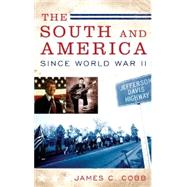The South and America Since World War II
, by Cobb, James C.- ISBN: 9780195166507 | 0195166507
- Cover: Hardcover
- Copyright: 12/3/2010
"With more finality than any occurrence since the Civil War," John Egerton observed in 1994, "the American triumph in World War II appeared to mark the conclusion of an old and outdated era in the SouthEL" Historian Morton Sosna has even suggested that, in its overall impact on the American South, World War II was "more important than the Civil War." At the very least, most scholars and other close observers of southern life would now quite likely agree with Bertram Wyatt-Brown that "the region has altered much more since the early 1940's than it did between 1865 and 1941." Emphasizing both the drama and complexity of the forces that have swept across the American South in the last sixty years, Cobb proposes a brief history of the region in the years since World War II, the only comprehensive survey of southern history since World War II. As a textbook, it would likely face almost no direct competitors. At this point the only book that is partially competitive is Numan V. Bartley's The New South, 1945-1980 (LSU Press, 1995, $21.95, paper), which, as the title indicates, covers only the period from World War II to 1980. The two major texts in southern history, John Boles, The South Through Time and William J. Cooper and Thomas E. Terrill, The American South, are comprehensive treatments that do not provide detailed attention to the dramatic events that have occurred since World War II. While there are now courses on the South since World War II and the South since 1900, the "bread and butter" textbook market for this book would be courses dealing with the South since Reconstruction. Current scholarly opinion seems to hold that the South we see today was shaped less by events in the years between the end of the Civil War and the beginning of World War II than by the events during and after World War II. Therefore, it seems entirely reasonable that an instructor in a semester course in southern history since Reconstruction might devote at least six weeks to the period since World War II. Hence, Cobb envisions a book of approximately 224 pages divided into six chapters averaging between 30 and 35 pages each, adaptable to semester courses on the twentieth-century South and the South since 1945. The book would also be useful for courses in southern culture or southern studies. Cobb's first book with Oxford University Press, The Most Southern Place on Earth: The Mississippi Delta and the Roots of Regional Identity (hardcover, 1992; paper, 1994), has sold approximately 13,000 copies. It has remained popular with general readers and has been utilized as a supplementary text in a variety of courses in southern history and culture and regional studies as well. His other book, Georgia Odyssey (University of Georgia Press, 1999), a 100-page synthesis of Georgia's history and culture, has sold well in bookstores and has been adopted in courses n Georgia history throughout the state as well as in one course entitled "Multicultural Georgia." His most recent book, Redefining Southern Culture: Mind and Identity in the Modern South (University of Georgia, 1999), has done well as a trade book and has been assigned in several courses in southern history and culture.







